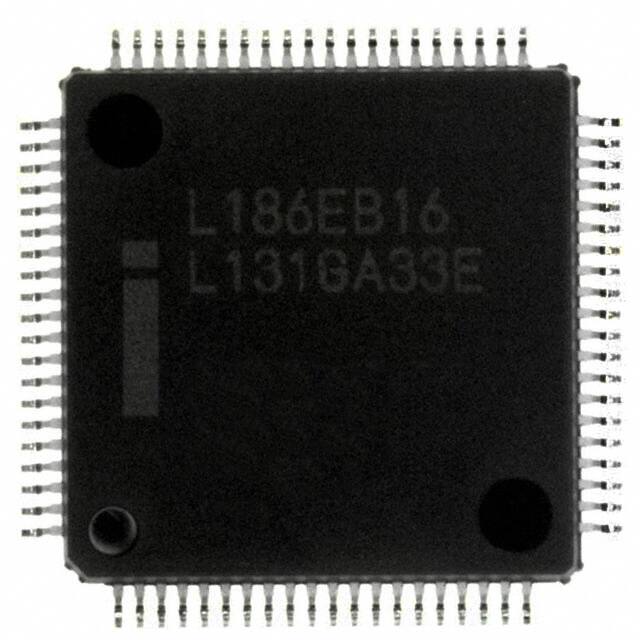Szczegóły produktu można znaleźć w specyfikacjach.

SB80L186EB16
Product Overview
Category: Integrated Circuit (IC)
Use: The SB80L186EB16 is a high-performance microprocessor designed for various applications in the field of embedded systems. It offers advanced processing capabilities and is suitable for use in a wide range of electronic devices.
Characteristics: - High performance - Low power consumption - Compact size - Versatile functionality
Package: The SB80L186EB16 is available in a compact and durable package, ensuring easy integration into electronic circuits.
Essence: This microprocessor is the heart of many embedded systems, providing the necessary computing power to perform complex tasks efficiently.
Packaging/Quantity: The SB80L186EB16 is typically sold individually or in small quantities, depending on the requirements of the user or manufacturer.
Specifications
The SB80L186EB16 microprocessor boasts the following specifications:
- Architecture: 16-bit
- Clock Speed: Up to 16 MHz
- Data Bus Width: 16 bits
- Address Bus Width: 20 bits
- Instruction Set: x86 compatible
- Operating Voltage: 3.3V
- Power Consumption: Low power design
- Temperature Range: -40°C to +85°C
- Package Type: Ceramic Pin Grid Array (PGA)
- Pin Count: 68
Detailed Pin Configuration
The pin configuration of the SB80L186EB16 microprocessor is as follows:
- VCC
- GND
- A0-A19
- D0-D15
- RD
- WR
- INTA
- NMI
- RESET
- CLK
- READY
- HOLD
- HLDA
- SSO
- SS1
- SS2
- SS3
- SS4
- SS5
- SS6
- SS7
- SS8
- SS9
- SS10
- SS11
- SS12
- SS13
- SS14
- SS15
- SS16
- SS17
- SS18
- SS19
- SS20
- SS21
- SS22
- SS23
- SS24
- SS25
- SS26
- SS27
- SS28
- SS29
- SS30
- SS31
- SS32
- SS33
- SS34
- SS35
- SS36
- SS37
- SS38
- SS39
- SS40
- SS41
- SS42
- SS43
- SS44
- SS45
- SS46
- SS47
- SS48
- SS49
- SS50
- SS51
- SS52
- SS53
- SS54
Functional Features
The SB80L186EB16 microprocessor offers the following functional features:
- High-speed data processing
- Efficient memory management
- Multiple I/O interfaces for peripheral device connectivity
- Built-in interrupt handling capabilities
- Power-saving modes for reduced energy consumption
- Support for various operating systems and software development tools
Advantages and Disadvantages
Advantages: - High performance for demanding applications - Low power consumption for energy efficiency - Compact size for space-constrained designs - Compatibility with x86 instruction set for easy software development - Versatile functionality for a wide range of applications
Disadvantages: - Limited availability of alternative models - Relatively higher cost compared to some other microprocessors in the market
Working Principles
The SB80L186EB16 microprocessor operates based on the principles of digital logic and data processing. It executes instructions stored in memory, performs arithmetic and logical operations, manages input/output devices, and handles interrupts. The processor's internal architecture and circuitry enable it to carry out these tasks efficiently and reliably.
Detailed Application Field Plans
The SB80L186EB16 microprocessor finds applications in various fields, including but not limited to:
- Industrial Automation: Controlling and monitoring systems in manufacturing plants.
- Automotive Electronics: Engine management, vehicle diagnostics, and multimedia systems.
- Communication Systems: Networking equipment, routers, and modems.
- Consumer Electronics: Smart home devices, gaming consoles, and multimedia players.
- Medical Devices: Patient monitoring systems, diagnostic equipment, and medical imaging devices.
Detailed and Complete Alternative Models
While the SB80L186EB16 microprocessor is a reliable choice for many embedded system applications, there are alternative models available in the market
Wymień 10 typowych pytań i odpowiedzi związanych z zastosowaniem SB80L186EB16 w rozwiązaniach technicznych
Sure! Here are 10 common questions and answers related to the application of SB80L186EB16 in technical solutions:
Q: What is SB80L186EB16? A: SB80L186EB16 is a microprocessor chip manufactured by Intel Corporation.
Q: What are the key features of SB80L186EB16? A: Some key features of SB80L186EB16 include an 80186 CPU core, integrated peripherals, and support for various interfaces.
Q: What applications can SB80L186EB16 be used for? A: SB80L186EB16 can be used in various technical solutions such as industrial automation, embedded systems, robotics, and control systems.
Q: What is the clock speed of SB80L186EB16? A: The clock speed of SB80L186EB16 is typically around 16 MHz.
Q: Does SB80L186EB16 support external memory expansion? A: Yes, SB80L186EB16 supports external memory expansion through its address and data bus.
Q: Can SB80L186EB16 handle real-time tasks? A: Yes, SB80L186EB16 can handle real-time tasks with its built-in timers and interrupt handling capabilities.
Q: What programming languages can be used to develop software for SB80L186EB16? A: Software for SB80L186EB16 can be developed using assembly language or high-level languages like C.
Q: How much power does SB80L186EB16 consume? A: SB80L186EB16 typically consumes low power, making it suitable for battery-powered or energy-efficient applications.
Q: Can SB80L186EB16 communicate with other devices? A: Yes, SB80L186EB16 supports various communication interfaces like UART, SPI, and I2C for seamless device-to-device communication.
Q: Is SB80L186EB16 still in production? A: No, SB80L186EB16 is an older microprocessor chip that is no longer in production. However, it may still be available from certain suppliers or in the secondary market.
Please note that the answers provided here are general and may vary depending on specific technical requirements and implementations.

